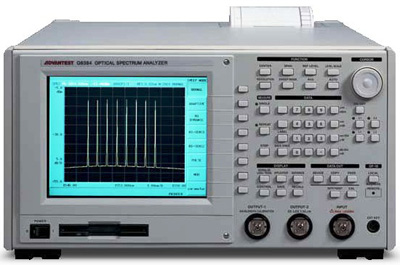
|
|
The Advantest Q8384 is a high-end optical spectrum analyzer using a monochromator developed by ADVANTEST and featuring a high dynamic range and a high wavelength resolution. It offers the highest level of performance with a 10pm wavelength resolution and a 20pm wavelength accuracy in the 1.55µm band. This enables precise measurement and evaluation of wavelength characteristics. The Q8384 has a wide dynamic range of 60dB at 0.2nm from the peak wavelength. Q8384 also integrates automatic NF measurement and arithmetic functions for optical fiber amplifiers with easy operation. Wavelengths can be measured with accuracy of ±20pm at 1530nm to 1570nm and ±40pm in the L band at 1570nm to 1610nm after calibration using a built-in calibration light source (Option 25). This enables high-spec laser diodes and optical filters used in DWDM to be evaluated accurately. The wavelength linearity is ±10pm at 1530nm to 1570nm enabling the spacing of wavelength-multiplexed signals to be measured accurately. Specifications. Wavelength Measurement range: 600 to 1700 nm. Wavelength Accuracy: <= ± 500 pm. Wavelength Linearity: <= ± 10 pm (1530 to 1570 nm). Wavelength Repeatability: <= ± 3 pm (1530 to 1610 nm). Wavelength Resolution Setting: 10 pm, 20 pm, 50 pm, 100 pm, 200 pm, 500 pm. Level Measurement range: -87 to +23 dBm (1250 to 1610 nm). Level Accuracy: <= ± 0.4 dB (1550 nm). Level Linearity: <= ± 0.05 dB (-50 to -10 dBm, 1550 nm). Level Repeatability: <= ± 0.02 dB (1530 to 1610 nm). Level Flatness: <= ± 0.2 dB (1530 to 1610 nm). Level Polarization dependence: <= ± 0.05 dB (1250 to 1610 nm). Level Dynamic range: 50 dB (at ± 100pm from peak wavelength). Sweep Span: From 0.2nm to full span and zero. Sweep Number of samples: 101, 201, 501, 1001, 2001, 500.
|